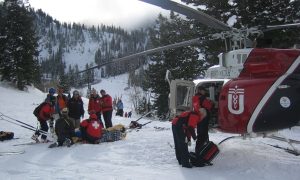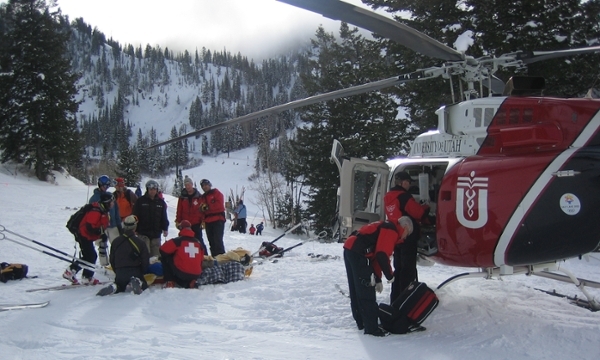Lakewood, CO – Each winter, we find ourselves facing the unfortunate duty of having to report fatalities at ski resorts around the nation. And every season, our readers perceive that these reports are indicative of a marked increase in fatal skiing accidents.
The truth is, however, that fatalities at ski resorts have held relatively steady for many years. This week’s flurry of news articles may seem to indicate otherwise, but your chances of dying in an accident at a ski resort actually remain incredibly small.
“It’s always tragic to report fatal ski and snowboard incidents,” said National Ski Areas Association (NSAA) President Michael Berry. “We recognize that the fatality rate fluctuates slightly each year; however, one’s chance of having a fatal accident on the slopes remains less than one in a million.”
NSAA reports that during the 2015-16 season there were 39 skier and snowboarder fatalities occurring at U.S. ski areas, compared to the 35 that occurred during the 2014-15 season. This is a slight increase from the previous season but remains right around the 10- year industry average of 38 fatalities per season. Based on 52.8 million total skier/snowboarder visits during the 2015-16 season, the fatality rate converts to 0.74 fatalities per one million skier visits during the 2015-16 season — less than one in a million, and slightly above the 10-year average rate of 0.67 fatalities per million skier visits.
A skier/snowboarder visit represents one person visiting a ski area for all or any part of a day or night. This includes full- and half-day, night, complimentary, adult, child, season pass, and all other ticket types.

NSAA collects fatality and catastrophic injury data from all U.S. ski areas annually, at the end of each season. NSAA compiles this data to provide information to the media and the skiing public that truly reflects the inherent risks to skiing and snowboarding guests at U.S. ski areas. The data reflects all incidents of fatality or catastrophic injury that occur within a ski area’s boundaries (backcountry fatalities and catastrophic injuries are not included in these statistics because they do not reflect the risk of fatality or catastrophic injury at ski areas for the skiing public), and during normal operating hours (a sledding death after hours at a ski area, for example). Also, NSAA does not include fatalities that are related to a pre-existing medical condition, such as a heart attack or stroke on a chairlift. Similarly, this data also does not include fatalities or catastrophic injuries suffered by ski area employees while working—again, because an employee’s death does not reflect the risk of fatalities or catastrophic injuries to the public.
Gender continues to be a significant factor in ski/snowboard fatalities. Of the 2015-16 fatalities, 31 were male and eight female. Equipment also plays a role in fatality data, with skiers accounting for 31 fatalities compared to seven snowboarder fatalities (for one fatality, this was unknown). At the time of these incidents, 23 of the 39 people who died were wearing helmets, while 15 of the fatalities were not wearing helmets (again, for one fatality, it was unknown). Overall, 80 percent of all skiers and snowboarders wore helmets during the 2015-16 ski season, according to a separate annual helmet usage study conducted by NSAA — which means that fatal skiing accidents disproportionately affected those who eschew helmets. And contrary to popular perception, for the last three ski seasons there have been no fatalities related to in-bounds avalanches.
Given this small data set, NSAA does not report fatalities or catastrophic injuries by individual state because of the wide variability of the data. Most states have one or two fatalities per season or fewer, making this variability even more pronounced.
Berry points out that resorts continue to emphasize the importance of personal responsibility and that safety remains a top priority at ski areas. Many have developed comprehensive safety education programs and actively promote the seven points of Your Responsibility Code, as well as the tenets of the Smart Style freestyle terrain safety initiative promoted by NSAA and ski resorts. The industry continues to support Heads Up, a safety initiative designed to promote on-mountain awareness, and each season ski areas across the country observe National Safety Awareness Month in January, a time that is dedicated to additional emphasis on guest and employee safety.
NSAA recently updated its Lids On Kids website committed to educating parents and children on the importance and proper use of snowsports helmets. In 2013, NSAA launched a new website Kids on Lifts to educate parents and their children about important safety practices for riding, loading, and unloading chairlifts. Meanwhile, NSAA’s Freestyle Terrain website strives to educate consumers about the proper use of terrain park features, with new, user-friendly signage for guests.
Skiing may never be as safe as sitting at home in your rocking chair, but swaying back and forth will never be as exhilarating as swooping down a mountainside through a foot of fresh powder. The fact of the matter, though, is that despite sensational stories of occasional horrific skiing fatalities, this sport isn’t nearly as dangerous as media accounts might make you believe that it is…our own accounts included.






The consistency of the number of ski accidents resulting in death may not reflect slope accidents. Better responses from Ski Patrol, other skiers with cell phones & local EMS may result & No Hands CPR training may be saving lives! Also, not reporting chair accident deaths related to a heart of other conditions may be giving ski resorts the ability to duck out of some responsibility for not requiring the safety bail to be down! Falling 30 ft to the icy snow below is a sure killer!
It could also indicate the ski resorts as a whole is not doing much to reduce the existing hazards.
Freak Accidents as ski resorts like to call them!
Of course, there is NO SUCH thing as a “FREAK ACCIDENT”, that is the terminology used when a group or ski resort wants to duck any responsibility! One ski accident in my area tried to call both one ski tree collision a freak accident & then tried again 30 days later on same slope & almost in same area!
Most all ski accidents can be prevented or greatly reduced by better management that includes MITIGATIONS! The National Group that represents the US Ski resorts and tries to convince the ski public that its ALL the skiers fault needs to stand up to the challenge and help improve the slope & ski slope management! Its not all the skiers fault on most accidents. The slope management is likely related to all accidents, including the skier collisions among other skiers. Its most likely this type of accident is mostly the skiers fault, but not all!
I like to speculate on actual near misses & then go look for corroboration by finding actual data. One windmill I charged at was Downhill ski deaths from hitting adjacent trees at Ski resorts. My belief is there are many close calls before a tree hit causes a death that I believe a ski resort should provide a mitigation. Many broken bones on ski slopes are a precursor to ones that result in death! Ski resort Management should not hide theses, but use them to make changes that reduce or prevent accidents on slope or even death!
An annual Major ski resort accidents: Hidden data that lead up to fatalities.
A WAG would be, there are likely hundreds of ski brush-by limb contacts that are likely to occur. Possibly also 20 hitting a tree and only resulting in so form of injury. Finally one death every few yrs from at speed hit directly into a tree trunk or large limb. Likely head contact with or without helmet. ! trail events and have a near miss of hitting a tree. Also 100 or so hitting just a part of a tree limb.